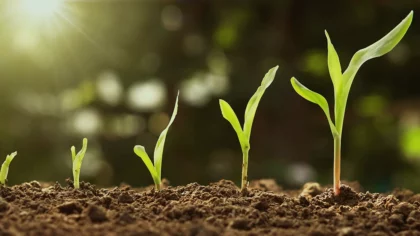Staying ahead of the technology curve means strengthening your competitive advantage. That is why we give you data-driven innovation insights into the agriculture industry. This time, you get to discover 5 hand-picked crop rotation solutions.
Global Startup Heat Map highlights 5 Top Crop Rotation Solutions out of 133
The insights of this data-driven analysis are derived from the Big Data & Artificial Intelligence (AI)-powered StartUs Insights Discovery Platform, covering 1.379.000+ startups & scaleups globally. The platform gives you an exhaustive overview of emerging technologies & relevant startups within a specific field in just a few clicks.
The Global Startup Heat Map below reveals the distribution of the 133 exemplary startups & scaleups we analyzed for this research. Further, it highlights 5 crop rotation solutions that we hand-picked based on criteria such as founding year, location, funding raised, and more. You get to explore the solutions of these 5 startups & scaleups in this report. For insights on the other 128 crop rotation solutions, get in touch.
eAgronom offers Artificial Intelligence-based Crop Planning
Effective crop rotation requires rigorous planning as farmers need to take into account multiple factors such as the mineral composition of the soil, logistics, and the market value of produce. Planning for years ahead may take up weeks and still require updates at a later date. To help farmers optimize crop rotation, startups develop automated crop planning solutions.
Estonian startup eAgronom develops a crop planning platform powered by AI. Farmers locate their fields on a map, choose preferable crops, and indicate the crop-growing areas. The startup’s algorithms calibrate the most fitting crop plan for the next 5 years. In addition to soil requirements, the platform takes into account field proximity to simplify logistics, thereby helping farmers create a comprehensive long-term crop plan.
Agricolus works on Crop Forecast Modeling
Crop rotation practices preserve the optimal nutrient composition of soils, allowing farmers to harvest better yields. At the same time, the lack of crop rotation practices dries nutrients off the land, decreasing its fertility and making it more susceptible to erosion. Therefore, startups provide crop forecasting services to help farmers produce better crops and decrease the environmental impact of agriculture.
Italian startup Agricolus offers crop forecast modeling services. The startup applies forecast models to optimize crop management practices such as rotation, fertilization, and irrigation. Through modeling and a proprietary decision support system (DSS) that is designed for precision agriculture, Agricolus optimizes crop yields and soil utilization.
FluroSat specializes in Agricultural Land Management & Control
Environmental auditors and land managers conduct monitoring and control operations to determine the sustainability of land use. To do this, they need solutions that enable effective measurement of farming practices, such as crop rotation and application of nutrients. Startups develop platforms that monitor farm management practices remotely and benchmark those measurements against government standards.
Australian startup FluroSat offers a management and control platform for land managers, conservation auditors, and environmental consultants. The startup’s platform enables effective monitoring of environmental impact from farming practices. Based on remote sensing data and crop monitoring algorithms, the platform allows users to verify crop rotation, estimate area health, and predict crop nutrient requirements for future seasons.
Applied Drone Innovations (ADI) advances Greenhouse Crop Monitoring
Although crop rotation is challenging in an open field, practicing it in greenhouses is more complicated due to the limited size and range of crops that grow in controlled environments. As a result, practicing crop rotation in greenhouses requires careful attention to the microclimate and plant health conditions. To deliver timely attention, startups apply robotic and sensor technology to advance greenhouse crop management practices.
Dutch startup Applied Drone Innovations develops crop monitoring solutions for greenhouses. The startup builds a range of products that include a germination analysis box – GA-Box, a monorail imaging robot – MIR, and a smart sensor network – USP. Together, these products effectively monitor the greenhouse environment. Additionally, the startup offers data analytics and visualization software, creating a complete solution to help growers improve crop rotation timing and better understand the effects of changing microclimate conditions within a greenhouse.
Dagan provides a Tillage Information System
Data from satellite and remote sensing provides details on tillage practices and the resulting soil conditions. This allows farmers, land managers, and local authorities to understand which practices have been in use and what is the best course of action to increase soil fertility and crop yields. To this avail, startups develop remote sensing solutions that optimize agricultural management.
US-based startup Dagan uses satellite data to provide a tillage information system to farmers, conservationists, and policymakers. The startup’s OpTIS and DNDC products combine satellite data and soil process models to develop historical and real-time insights into agricultural practices. The system provides insights on soil carbon, nitrogen levels, and greenhouse gas emissions to enable informed crop rotation decisions that correspond best to the current biochemical properties of the land.
Discover More AgriTech Startups
AgriTech startups such as the examples highlighted in this report focus on smart and precision farming, irrigation, and desert farming. While all of these technologies play a major role in advancing agriculture, they only represent the tip of the iceberg. To explore more AgriTech technologies, simply get in touch to let us look into your areas of interest. For a more general overview, you can download our free AgriTech Innovation Report to save your time and improve strategic decision-making.









